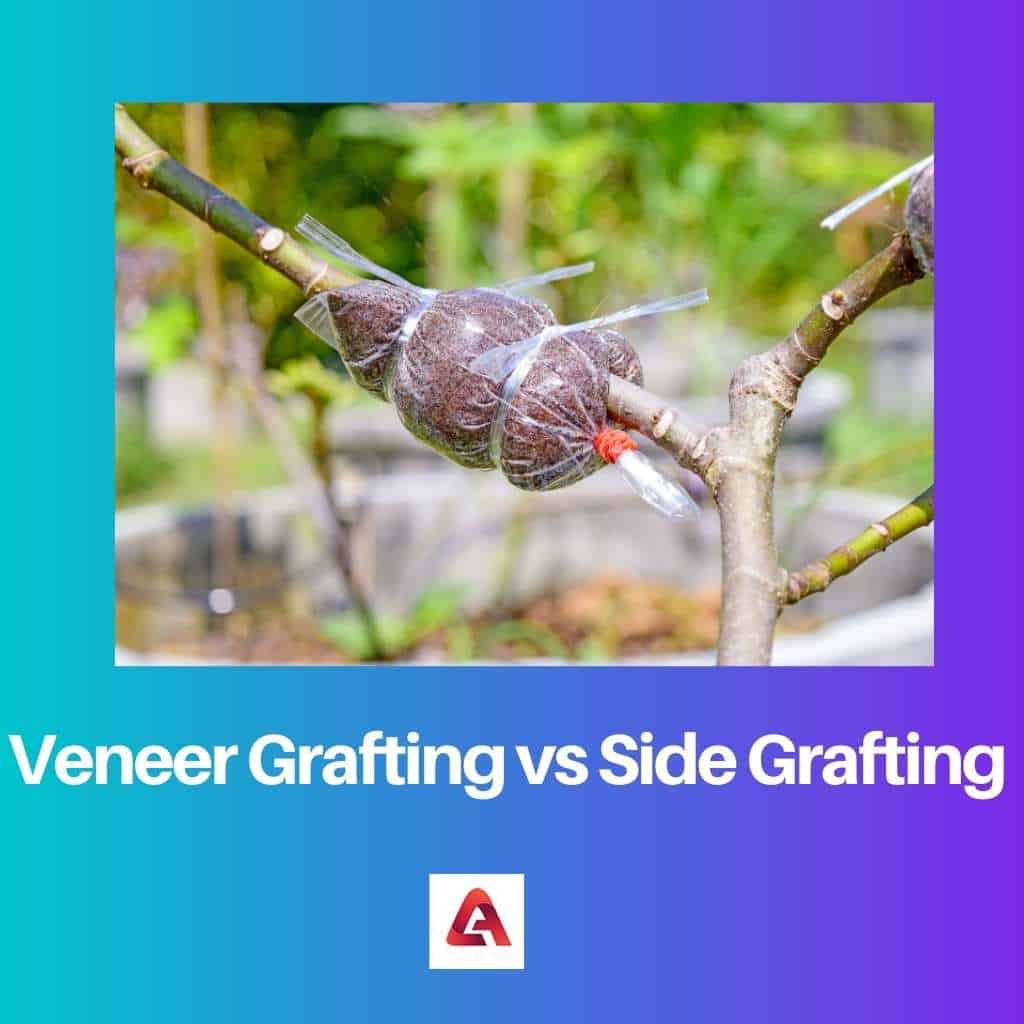The grafting of plants is a very popular gardening technique that is used to grow plants with mixed characteristics.
It is a technique of joining two or more plants during the growth stage, to grow a single plant with the characteristics of all the combined plants. There are different techniques of grafting.
Key Takeaways
- Veneer grafting involves attaching a scion to the rootstock’s side by cutting a thin layer of bark, while side grafting connects the scion to the rootstock’s side using a diagonal cut.
- Veneer grafting suits conifers and broadleaf trees, whereas side grafting is best for fruit trees and ornamental plants.
- Veneer grafting provides a larger contact area between scion and rootstock, promoting better healing and growth, while side grafting may require more support during the healing process.
Veneer Grafting vs Side Grafting
Veneer grafting is precise and can be used to graft small scions onto large rootstocks, but it requires more skill and experience to perform successfully. Side grafting is simpler and easier to perform but may not be suitable for grafting small scions onto large rootstocks.

Veneer grafting is a popular grafting technique that is used to join two plants, to grow a single plant.
This technique is used for plants that have a moderate stock size, ranging above 3 centimeters in diameter.
In this technique, scions of the plants are required to be as thick as a pencil.
Side grafting is another popular grafting technique. This technique is used for plants that have thin stocks. Usually, potted plants and other flowering plants are grafted using this technique.
In this grafting technique, the scions of the plants are required to be thin and with a uniform cross-section.
Comparison Table
| Parameters of Comparison | Veneer Grafting | Side Grafting |
|---|---|---|
| Type of plants | Medium to large bushes | Potted plants and flowering plants |
| Scion size | Scions of the plants are required to be as thick as a pencil | Thin scions are required |
| Stock size | Typically ranging above 3 centimeters | Typically ranging below 1 centimeter |
| Cutting pattern | Inlay cuts are made on the stock | Square cuts are made on the stock |
| Protective covering | Plastic bags are preferred | Wax is preferred |
What is Veneer grafting?
Veneer grafting is a popular type of grafting technique. It is used to mix the characteristics of two plants into a single plant, by combining the plants during the growth stage.
For combining the plants the scions of the mating plants are planted into the stocks of the base plant.
Veneer grafting is used for plants that have a larger diameter of stock. The stock diameter should range from 3 centimeters or more.
Thus this technique is used for larger plants, such as fruiting trees and large shrubs.
In this grafting technique, inlay cuts of parallel cuts are made into the stock of the base plant. Next, the scions of the mating plants are planted into the cuts made on the stock.
The scion size must also meet the specific size requirement, to allow proper rooting into the stock, as well as to improve the growth and health of the plants.
Typically scions are required to be as thick as a pencil when performing Veneer grafting.
The grafted portion has to be protected after the process, as the rooting process takes a longer time.
Thus the protection to the grafts is provided by wrapping the grafted portion with a plastic bag and securing the bag with tape.

What is Side Grafting?
Side grafting is a type of grafting technique that is used to combine two or more plants. This technique is used to grow a single plant with the characteristics of two or more plants.
Typically this technique is used on smaller plants, such as potted bushes or flowering plants.
In the Side grafting process, square cuts are made on the stocks of the base plant. The process requires stocks to be of smaller size, between a few hundred millimeters to 1 centimeter.
The scions of the mating plants are then inserted into the cute made on the base stock. For proper rooting of the scions as well as good growth of the plant, the scion diameter must also be small.
The process is slightly more difficult than the other grafting techniques, mainly because of the smaller sizes of stocks and scions.
As potted plants are used, the diameter of stocks as well as of scions are relatively smaller when compared to the diameter of stocks and scions used in Veneer grafting.
After grafting the scions into the stock, the grafted portion is protected with wax. Wax is applied at the bottom of the grafted portion, near the root of the grafting.

Main Differences Between Veneer Grafting and Side Grafting
- In Veneer grafting medium to large bushes. In Side grafting, small otted plants are used
- In Veneer grafting, scions of the plants are required to be as thick as a pencil. Side grafting requires thin scions
- Veneer grafting requires stock diameter greater than or equal to 3 centimeter. Side grafting requires smaller stock diameter.
- In Veneer grafting, inlay cuts are made. In Side grafting square cuts are made
- Veneer grafting uses plastic bags for protection. Side grafting uses wax for protection.





